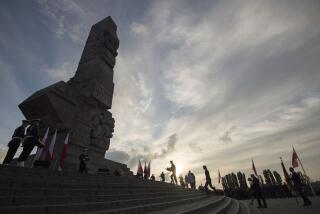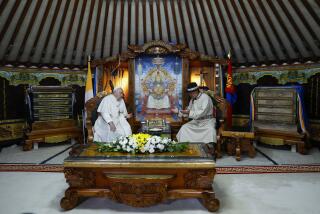Mongolians Seek Truth of Purges : Asia: After decades of secrecy, the bloody facts are being brought to light.
- Share via
ULAN BATOR, Mongolia — The man who organized Mongolia’s mass executions six decades ago showed no remorse as he described sending the victims off.
“Many were crying or asking not to be killed,” Ish Tseren, now 86, told a visitor to his small tent home. “But once the decision was made, they had to be shot.”
The orders came from Marshal Khorloin Choibalsan, who for more than two decades ruled Mongolia much the way Josef Stalin ruled the Soviet Union. Historians believe he took directions from Stalin.
“Maybe later he could say, ‘You are the enemy. You must be killed, too,’ ” Tseren said, trying to justify his willingness to follow Choibalsan’s orders. He was head of a special commission that carried out the executions.
Information is only slowly emerging about the purges of the 1930s, an era obscured by official lies until Mongolia’s ruling Communist Party ended decades of authoritarian rule and introduced a multi-party system in 1990.
Tseren said he has chosen to speak out about his role in Mongolia’s brutal purges because he wants the truth known. He also said he hopes to get a government-assigned apartment because of his cooperation in exposing secrets.
A Foreign Ministry official helped arrange the interview and translated Tseren’s comments from Mongolian into English, reflecting the country’s increasing openness as it forges a new national identity following years of Soviet domination.
In early June, researchers exhumed the remains of 180 people, some of them Buddhist monks, from mass graves near Moron, a city 250 miles northwest of Ulan Bator.
Munhdalain Rinchin, a historian and head of a government-approved research center examining political repression, estimates as many as 5,000 people executed by Choibalsan’s security forces may be buried near Moron.
When digging began last year, the government denied the mass graves contained bodies of Mongolians purged in 1937 and 1938. Officials now refuse to comment at all.
The government estimates 30,000 people were killed when Choibalsan ordered his police force to purge alleged enemies and wipe out Buddhism, which was virtually the national religion. Monks and intellectuals were special targets.
Tseren said his own brother, a monk, was jailed.
Rinchin said population records and lists of people missing since the 1930s indicate the actual number killed could be as high as 100,000. Mongolia’s population then was about 700,000.
Rinchin said diggers near Moron found skulls with holes in the back from pistol shots.
Many skeletons were found with the head lower than the rest of the body, indicating the victim was shot while kneeling on the edge of the pit and then toppled into it, he said. Their hands were tied behind their backs.
Rinchin said there are no plans to prosecute Tseren or others involved in the executions. They are being encouraged to tell their stories so the truth can be known.
Tseren, heavily wrinkled but healthy, lives in a small nomad’s tent, called a ger, on the edge of Ulan Bator. Tseren’s second wife and her 16-year-old son live with him.
With traditional courtesy, he offered guests bowls of fermented milk while he smoked a cigarette to its dregs. He told his story without emotion.
Prisoners who refused to admit to being “enemies of the people” were beaten, he said.
They were placed on tall stools next to a hot stove for interrogations that sometimes lasted days. Sometimes an exhausted prisoner tumbled down and was beaten.
Tseren said Soviet advisers had told the Mongolians to use such methods. He said many innocent people confessed, knowing they would be killed anyway.
Choibalsan sometimes was drunk when name lists of people on trial were placed before him, Tseren said. Without weighing the cases, he would arbitrarily tick off who should be executed.
Tseren, who insisted he did not personally kill anyone, said it was his job to “organize” those ordered to die.
More to Read
Sign up for Essential California
The most important California stories and recommendations in your inbox every morning.
You may occasionally receive promotional content from the Los Angeles Times.













